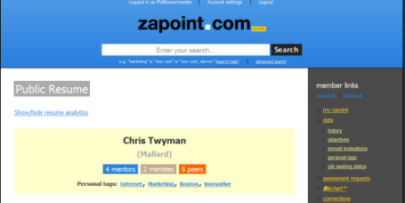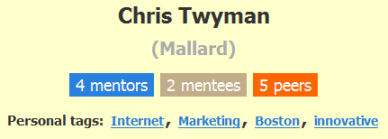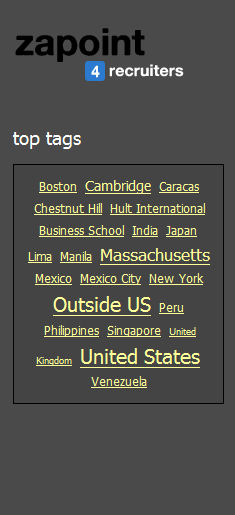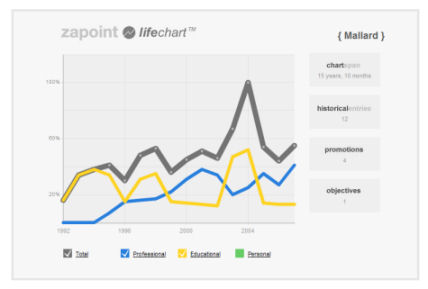So how do you look for a job on the Internet? There are many different approaches, of course, but most folks end up doing one or the other of the following (or both):
1. Register with an employment site such as Monster, where you input an electronic version of your resume and then search the database of job listings looking for a match.
2. Network via a social networking site such as LinkedIn or FaceBook to uncover (via connections) the unpublished job market where a position specific to your skills and experience is just waiting to be discovered / developed.
Well, meet Zapoint — a newly launched startup that takes a somewhat different approach to seeking employment on the Web. Like Monster, Zapoint allows you to post your resume online:

One of the differences with a site such as Monster becomes immediately apparent, but since the image above is shrunken rather excessively, let me magnify the relevant part:

So before we even begin to learn about this individual’s education or job experience, we get some contextual information on him. The mentors, mentees, and peers that are linked below his name are nodes in his budding professional network. Members of the network allow the job-seeker to demonstrate how well-connected he is; they also act to confirm the accomplishments listed on the resume (something that’s difficult to do with other electronic resume sites.) Mentors help define the direction that the job-seeker might like to go; mentees allow him to provide that kind of direction to others.
Below the professional network information, we see personal tags related to the job-seeker’s resume. Zapoint is very much a tag-driven, Web 2.0-type environment:

Although we’re still not yet to the resume — which is actually a pretty standard thing; I’m not even going to reproduce it here — we now come to what I consider to be one of the two big differentiators for Zapoint: the Life Chart:

Every Zapoint member has a Life Chart. The website describes it as a kind of a stock chart for your life. By providing a numerical (and graphic) assessment of each job-seekers’ professional and educational history, as well as personal accomplishments, Zapoint is creating what they call a “common currency” for the employment market. Even if that description turns out to be a bit of an overreach, this certainly is an innovative idea which should — at the very least — allow for apples-to-apples employer comparisons between job candidates. And that is no small thing.
Plus, the idea of a neat, visual summary of the information presented in a resume seems like exactly the sort of thing the Web was designed to provide. It’s surprising that no one has implemented something like this before. I hope that Zapoint expands the background explanation of the Life Chart and provides some specific examples of how the chart might be used.
Zapoint’s other major differentiator also has to do with currency: a thousand dollars worth of the stuff. They are offering $1000 hiring bonus to every job-seeker who gets signed on to their new position via the Zapoint service. I have to say that I love this idea! Get a job; get $1000. It’s so straightforward. Again, you have to wonder why no one has thought of it before.
For any of it to work — the networking, the viability of the Life Chart as a basis for comparison, the cash hiring bonus — Zapoint will have to attract a large number of users and show some real success in helping people to find a job via the Internet. But anybody who wants to help you build your network, find a new job, AND throw some money your way…well, you pretty much have to root for them. Go get ‘em, Zapoint!
FULL DISCLOSURE: Chris Twyman, the founder of Zapoint (whose public resume I showed above), is a friend and former colleague. Plus, he listens to FastForward Radio. Need I say more?






